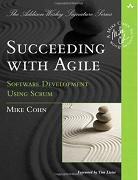Succeeding with Agile
This is the definitive, realistic, actionable guide to starting fast with Scrum and agile–and then succeeding over the long haul. Leading agile consultant and practitioner Mike Cohn presents detailed recommendations, powerful tips, and real-world case studies drawn from his unparalleled experience helping hundreds of software organizations make Scrum and agile work.
Succeeding with Agile is for pragmatic software professionals who want real answers to the most difficult challenges they face in implementing Scrum. Cohn covers every facet of the transition: getting started, helping individuals transition to new roles, structuring teams, scaling up, working with a distributed team, and finally, implementing effective metrics and continuous improvement.

Review By: Peter Gabris
06/22/2010What makes a book a classic? Time. Only time will tell if the book keeps its prominent place on a bookshelf, and we can argue that completeness, usefulness, timelessness, and non-triviality are the main factors to that longevity. The book Succeeding with Agile Software Development Using Scrum has a complete coverage of the Scrum-based agile process. The book is divided into five parts: Getting Started, Individuals, Teams, The Organization, and Next Steps. The only thing intentionally left out is an introduction to Agile and Scrum. The author argues that there are enough introductory books already available and he provides a very good recommended reading list, including Web sites. After all, the introductory part would have the least visited pages in a long run.
The scope of the book is not only wide, it is deep, too. Each important topic has real-life examples, a list of things to try immediately, notes, cross-references on the margin, and even expected objections spelled out and answered. Chapters end with a detailed annotated list of additional reading.
Software quality is at the center of the iron triangle, which was popularized by the Project Management Institute. Scope, Schedule and Resources make up the sides of the triangle. If management tries to push on all three edges, then quality suffers. Cohn writes, "As part of transitioning to Scrum, key project stakeholders, developers, and product owners will need to learn to make changing scope their first choice" (page 293). This is a great victory for software quality. Another one is the change of the attitude towards the quality and building the quality into the software creation process. Testing is not any more an after-activity that can be cut off when the delivery date is close. Programmer and tester work together on each new feature. Test design, development, and testing itself occur alongside coding.
Mike Cohn has lived Scrum for more than fifteen years and provided guidance to many corporate clients. Mike's Web sites blog.MountainGoatSoftware.com and SucceedingWithAgile.com became the place for anything agile and scrumworthy. The community around those Web sites grew in Scrum knowledge by reading the Guru’s musings. Actually, most of the chapters of the book, if not the whole book, appeared on the SucceedingWithAgile.com site and went through endless refinements in discussions with readers. Mike’s ability to answer questions, sometimes in the most unusual times, is proverbial.

User Comments
As one of the early reviewers of this book, I want to emphasize the title: Succeeding With Agile. While it is True that Mike takes a Scrum focus (hence the subtitle), I felt (and still do) that the advice in the book is applicable whether one takes a fully Scrum approach or not.
I recommend this book to everyone I come across as I find it the best single volume "handbook" to actual Agile adoption. Indeed, rather than actually engaging in "training" at one client, I asked them to get copies of the book and read it. Then we held "discussion" sessions about what they read. I think this worked out better than formal training. True, it took people longer, but the discussion was at a much deeper, more rewarding level for the organization.